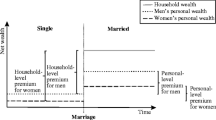Abstract
In theory, people who own real estate should have advantage finding a partner in the marriage market. Empirical analyses along this line, however, face three issues. First, it is difficult to identify any causality for whether housing facilitates marriage or expected marriage facilitates a housing purchase. Second, survey samples usually do not cover very wealthy people, and so the observations are top coding in the wealth dimension. Third, getting married is a dynamic life cycle decision, and rich life-history data are rarely available. This paper uses registry data from Taiwan to estimate the impact of males’ housing wealth on their first-marriage duration, taking into account all three issues mentioned above. We find that a 10% increase in real estate wealth increases probability of a man getting married in any particular year by 3.92%. Our finding suggests that housing or real estate is a status good in the marriage market.
Similar content being viewed by others
Notes
Source: http://www.ios.sinica.edu.tw/sc/.
We use the last closing price before July 31 if July 31 is on a weekend.
There are some errors in parents’ age in family records. If the difference between father/mother’s age and children’s age falls outside of [15, 60], then it is considered as a data error and thus dropped from the observations. Such errors account for about 0.6% of the sample.
We interact the five instruments in Table 6 with his brother’s real estate.
References
Albouy D, Zabek M (2016) Housing inequality. NBER Working Paper 21916
Bowmaker SW, Emerson PM (2015) Bricks, mortar, and wedding bells: does the cost of housing affect the marriage rate in the US? East Econ J 41:411–429
Burgess S, Propper C, Aassve A (2003) The role of income in marriage and divorce transitions among young Americans. J Popul Econ 16:455–475
Chu CC, Yu R-R (2010) Understanding Chinese families: a comparative study of Taiwan and Southeast China. Oxford University Press, Oxford
Das Gupta M, Jiang Z, Li B, Xie Z, Chung W, Bae H (2010) Why is son preference so persistent in East and South Ssia? A cross-country study of china, India and the Republic Of Korea. The Journal of Development Studies 40:153–187
Dew J, Price J (2011) Beyond employment and income: the association between young adults’ finances and marital timing. J Fam Econ Iss 32:424–436
Frank RH (2007) Falling behind: how rising inequality hurts the middle class? University of California Press, Berkeley
Gibson-Davis CM (2009) Money, marriage, and children: testing the financial expectations and family formation theory. J Marriage Fam 71:146–160
Grier KB, Hicks DL, Yuan W (2016) Marriage market matching and conspicuous consumption in China. Econ Inq 54:1251–1262
Jennings EA, Axinn WG, Ghimire DJ (2012) The effect of parents’ attitudes on sons’ marriage timing. Am Sociol Rev 77:923–945
Laeven L, Popov A (2017) Waking up from the american dream: on the experience of young americans during the housing boom of the 2000s. Journal of Money, Credit and Banking 49:861–895
Lin I-F, Goldman M, Weinstein Y-H, Lin T, Gorrindo TS (2003) Gender differences in adult children’s support of their parents in Taiwan. J Marriage Fam 65:184–200
Marsh A (2011) Social status and the demand for housing. Working Paper. University of Bristol
Oppenheimer VK (2003) Cohabiting and marriage during young men’s career-development process. Demography 40:127–149
Oppenheimer VK, Kalmijn M, Lim N (1997) Men’s career development and marriage timing during a period of rising inequality. Demography 34:311–330
Papke L, Wooldridge JM (2008) Panel data methods for fractional response variables with an application to test pass rates. J Econ 145:121–133
Rivers D, Vuong Q (1988) Limited information estimators and exogenous test for simultaneous probit models. J Econ 39:347–366
Schneider D (2011) Wealth and the marital divide. Am J Sociol 117:627–667
South SJ (2001) The variable effects of family background on the timing of first marriage: United States, 1969-1993. Soc Sci Res 30:606–626
Wei S-J, Zhang X, Liu Y (2017) Home ownership as status competition: some theory and evidence. J Dev Econ 127:169–186
Wooldridge JM (2010) Econometric analysis of cross section and panel data, 2nd edn. MIT Press, Cambridge
Wrenn DH, Klaiber HA, Newburn DA (2017) Confronting price endogeneity in a duration model of residential subdivision development. J Appl Econom 32:661–682
Xie Y, Raymo JM, Goyette K, Thornton A (2003) Economic potential and entry into marriage and cohabitation. Demography 40:351–367
Yu J, Xie Y (2015) Changes in the determinants of marriage entry in post-reform urban China. Demography 52:1869–1892
Yu WH, Su KH, Chiu CT (2012) Sibship characteristics and transition to first marriage in Taiwan: explaining gender asymmetries. Popul Res Policy Rev 31:609–636
Acknowledgments
We thank Ruoh-Rong Yu and Hao-Chun Cheng for their participation in the early stage of this project. We also thank Chien-Yu Chen and Chun-Hung Tsang for the research assistance. We are grateful for the valuable comments of two anonymous referees and the suggestions of the Editor and Co-Managing Editor of the Journal of Population Economics. An earlier version of this paper was presented at Oxford University, Paris School of Economics, and Academia Sinica, where useful comments and suggestions by John Ermisch, Thomas Piketty, and many seminar participants were greatly appreciated.
Author information
Authors and Affiliations
Corresponding author
Additional information
Responsible editor: Junsen Zhang
Publisher’s note
Springer Nature remains neutral with regard to jurisdictional claims in published maps and institutional affiliations.
Rights and permissions
About this article
Cite this article
Chu, C.Y.C., Lin, JC. & Tsay, WJ. Males’ housing wealth and their marriage market advantage. J Popul Econ 33, 1005–1023 (2020). https://doi.org/10.1007/s00148-019-00763-4
Received:
Accepted:
Published:
Issue Date:
DOI: https://doi.org/10.1007/s00148-019-00763-4




